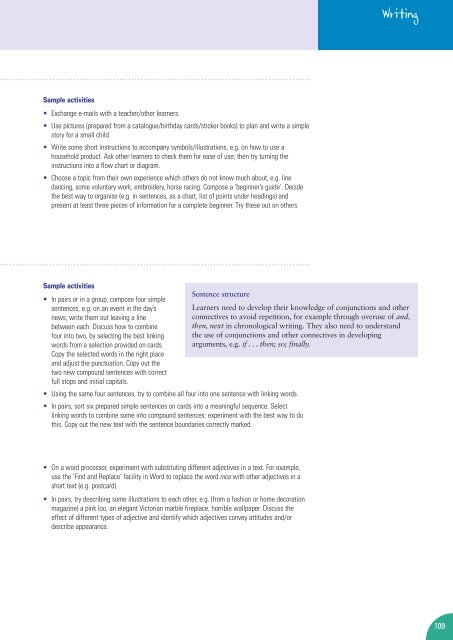Adult Literacy Core Curriculum - Nationally developed Skills for Life ...
Adult Literacy Core Curriculum - Nationally developed Skills for Life ...
Adult Literacy Core Curriculum - Nationally developed Skills for Life ...
Create successful ePaper yourself
Turn your PDF publications into a flip-book with our unique Google optimized e-Paper software.
Sample activities<br />
• Exchange e-mails with a teacher/other learners.<br />
• Use pictures (prepared from a catalogue/birthday cards/sticker books) to plan and write a simple<br />
story <strong>for</strong> a small child.<br />
• Write some short instructions to accompany symbols/illustrations, e.g. on how to use a<br />
household product. Ask other learners to check them <strong>for</strong> ease of use; then try turning the<br />
instructions into a flow chart or diagram.<br />
• Choose a topic from their own experience which others do not know much about, e.g. line<br />
dancing, some voluntary work, embroidery, horse racing. Compose a ‘beginner’s guide’. Decide<br />
the best way to organise (e.g. in sentences, as a chart, list of points under headings) and<br />
present at least three pieces of in<strong>for</strong>mation <strong>for</strong> a complete beginner. Try these out on others.<br />
Sample activities<br />
• In pairs or in a group, compose four simple<br />
sentences, e.g. on an event in the day’s<br />
news; write them out leaving a line<br />
between each. Discuss how to combine<br />
four into two, by selecting the best linking<br />
words from a selection provided on cards.<br />
Copy the selected words in the right place<br />
and adjust the punctuation. Copy out the<br />
two new compound sentences with correct<br />
full stops and initial capitals.<br />
Sentence structure<br />
• Using the same four sentences, try to combine all four into one sentence with linking words.<br />
• In pairs, sort six prepared simple sentences on cards into a meaningful sequence. Select<br />
linking words to combine some into compound sentences; experiment with the best way to do<br />
this. Copy out the new text with the sentence boundaries correctly marked.<br />
• On a word processor, experiment with substituting different adjectives in a text. For example,<br />
use the ‘Find and Replace’ facility in Word to replace the word nice with other adjectives in a<br />
short text (e.g. postcard).<br />
• In pairs, try describing some illustrations to each other, e.g. (from a fashion or home decoration<br />
magazine) a pink loo, an elegant Victorian marble fireplace, horrible wallpaper. Discuss the<br />
effect of different types of adjective and identify which adjectives convey attitudes and/or<br />
describe appearance.<br />
Writing<br />
Learners need to develop their knowledge of conjunctions and other<br />
connectives to avoid repetition, <strong>for</strong> example through overuse of and,<br />
then, next in chronological writing. They also need to understand<br />
the use of conjunctions and other connectives in developing<br />
arguments, e.g. if . . . then; so; finally.<br />
109

















